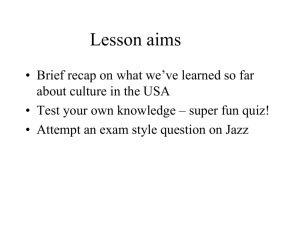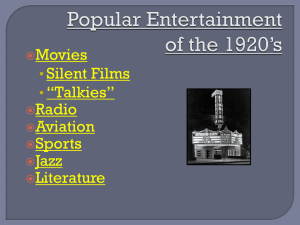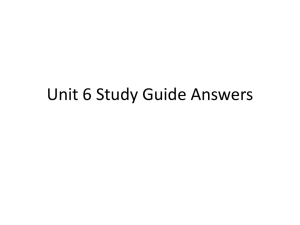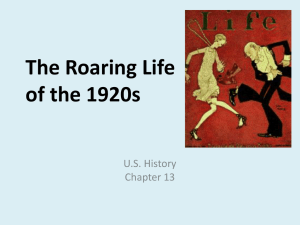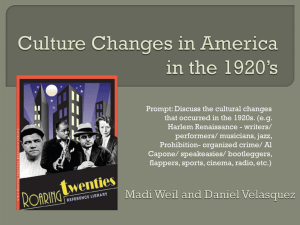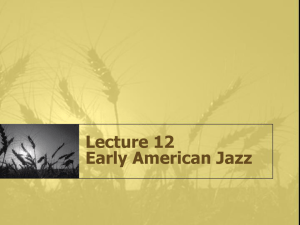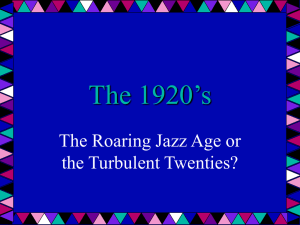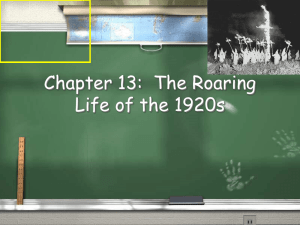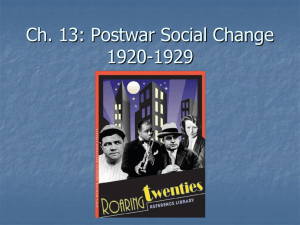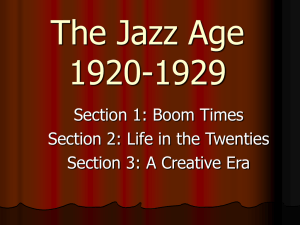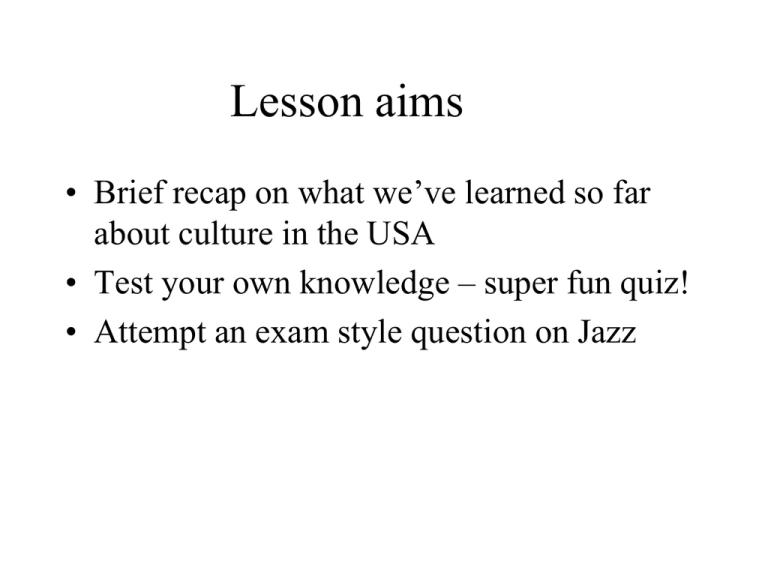
Lesson aims
• Brief recap on what we’ve learned so far
about culture in the USA
• Test your own knowledge – super fun quiz!
• Attempt an exam style question on Jazz
‘The Roaring Twenties’
The image
• 1920s America – “One long, crazy party, with
jazz music playing on the radio, young
fashionable women known as flappers wildly
dancing the Charleston, large quantities of
illegal alcohol being consumed, and everyone
behaving in a scandalous manner.”
Roaring 20’s
• The 1920’s were a period of great
turmoil and contrast for the USA.
• There was liberation and rebellion
against traditional values for some
• And great anxiety for others who
felt that the American way of life
was being destroyed.
• Hence the term “roaring 20’s”
‘The Roaring Twenties’
The reality
• In the aftermath of the war people were
determined to have fun.
• They had more money and more leisure time.
• Women were freer than ever
• The entertainment industry boomed.
• The 1920s were the golden age for Hollywood
films.
• It was also the Jazz Age with its crazes for
new music and dances.
Entertainment
• During the 1920’s the entertainment
industry blossomed.
• The average working week dropped
from 47.4 to 44.2 hours so people had
more leisure time.
• Average wages rose by 11%
• A lot of this spare time and money
was channelled towards
entertainment.
Music/Radio
‘The Jazz-Age’
Radio/jazz
• Almost everyone in the USA listened to
the radio.
• In August 1921 there was only one licensed
radio station in America.
• By the end of 1922 there were 508 of
them.
• The radio enabled people to listen to JAZZ
music.
Jazz
• Jazz music became an obsession
among young people.
Black people moved from the countryside
and brought jazz and blues music with
them. Jazz was played on the radio with dance
marathons and dance crazes like the
charleston. The 1920’s became known as
the JAZZ AGE.
The older generation saw Jazz as a
corrupting influence on the young people
of America.
Super Fun Quiz!!!!
1. What type of music became popular in the
1920’s? (1)
2. Where did it originate from? (1)
3. Name three dances popular in the twenties
(3)
4. Name two musicians famous at this
time (2)
5. Name a famous black female singer who died
because she wasn’t allowed to go to a white
hospital (1)
6. How did people listen to this new music at
home? (2)
7. Why did some dance halls ban Jazz music
from playing? (1)
8. Did this make Jazz music more or less
exciting to young people? (1)
9. Which types of establishments did Jazz music
flourish in? (1)
10. Why did so many people have radios at
home? (2)
Let’s check the answers! – Score out of 15
Second Lesson
• Set up homework on fads, games and crazes
• To understand why sport and other leisure
activities became so popular during 19201929
• To practice an exam style question
TASK
You must carry out detailed research on ALL of the following:
Crazes and Fads
Heroes
Dance Marathons
Crosswords
Flagpole Sitting
Newspapers and Magazines
Beauty Contests
Charles Lindbergh
Gertrude Ederle
Amelia Earhart
to be presented on Monday 23rd January either through a power
point presentation, website, Windows Movie Maker, or a leaflet.
Possible to do this in pairs if you can meet up in your spare time.
It is vital that you do this properly as there is no room for us to make
notes in the booklets and there will be exam questions on this topic
Fads, Crazes and Popular
Language
In the 1920s
Dance Marathons
Dance Marathons became very popular in the 1920s. They gained
popularity because it was suppose to be quick easy money for out
of work people. Most people went for the money, but other went to
gain stardom. The music was played slow to hopefully lull you to
sleep, but twice an hour it would be picked up, these were called
sprints. The only real rule was, no falling asleep. Some contests
would have breaks, but usually only a half hour for the first week,
and it would go down until there were none left. There was the
occasional staged contestants, to help cause fights and to entertain
onlookers. The longest dance marathon recorded was twenty-two
weeks and three and a half days. Dancers would do anything to
win, one woman would even pickle her feet. Dance marathons were
later outlawed due to the hard physical strain.
Games
Games started to gain popularity in the 1920s.
Whether you were playing with your family or friends,
it was a guaranteed good time. Some popular game were,
Mahjong, Ouija boards, and Crossword puzzles.
Mahjong - is a game similar to Dominos.
Ouija boards - a game where you supposable talk to “spirits”.
Crossword puzzles - a word game where you fill in the blanks,
with the information they give you.
Popular Language/Slang
In the 1920s, slang started to gain popularity.
Morals were now being questioned, and youth culture
was on the rise because of urbanization. Prohibition was
causing people to use slang to hide bootlegging, and to
help keep speakeasies hidden. Other people just wanted
to be unique.
Some slang popular back in the 1920’s are the
following:
1. baloney
2. cheaters
3. darb
4. dumb Dora
5. flat tire
6. gaga
7. gam
8. hard-boiled
9. hotsy-totsy
10. Jake
11. ritzy
12. Sheba
13. Sheik
14. spifflicated
15. white cow
1. baloney - nonsense
2. cheaters - glasses
3. darb - excellent person or thing
4. dumb Dora - stupid girl
5. flat tire - dull, boring person
6. gaga - crazy/silly
7. gam - girl’s leg
8. hard-boiled - tough
9. hotsy-totsy - pleasing
10. Jake - okay
11. ritzy - elegant
12. Sheba - young woman with sex appeal
13. Sheik - young man with sex appeal
14. spifflicated - drunk
15. white cow - vanilla milkshake
Sport
Sport was another area that boomed in the 1920’s , Baseball became a
big money sport with teams like the New York Yankees and the Boston
Red Sox. Prominent figures such as Al Capone were Baseball fans.
The greatest sports hero
of the 1920’s was George
Herman Ruth-’Babe
Ruth’. He was the star of
the NYY.
Another great sportsperson
was Oscar Charleston who
played in the Negro League.
He, too is regarded as one of
the best players of all time
but because of the colour of
his skin he wasn’t allowed to
play in the major leagues
Boxing
Spectators flocked to see all
big sporting events, especially
boxing matches.
The country’s most
famous boxing star was
Jack Demsey. A
fearsome world
heavyweight champion
known as the ‘Manassa
Mauler’.
American Football
In American Football Red Grange
and Knute Rockne were the two
stars of the time. At a time when
the average salary was $100 per
game, Grange earned $100,000
for the 19 game schedule
Tennis
Bill Tilden and Helen Wills
were the two stars of
tennis and their success
helped to foster the
growth of the sport. As a
result, participation in
tennis increased
dramatically. By the end of
the decade there were
more than 1000 tennis
clubs and enough municipal
courts to accommodate
more than 1 million players
across the USA
Sporting Icons
As a result of this growth in sporting activity a
fascination developed with sporting records
and sports stars. Matches and results were
analysed player’s technique discussed. The
1920’s witnessed an emergence of sporting
icons, whose activites and lifestyles received
constant media attention. This in turn helped
to popularise and increase participation in
sporting events amongst the population at
large
Overview
-*The 1920’s brought on the rise of youth culture.*
-Popular Language - Used to seem unique, urbanization played a
big role.
-Clothing Trends - Also used for uniqueness, to get away from
tradition, to be risqué.
-Dance Marathons - Big way to make quick money, something to
do in spare time.
-Games - Help to kill time, Mahjong, Ouija boards, Crossword
Puzzle.
-Music - Jazz was popular, mainly among youth, blamed for
everything, if you danced to Jazz you were considered morally
loose.
-Flappers - Modern woman of the 1920s, short hair, short skirts,
sleeveless baggy dresses, rolled down hose, powdered knees, lots
of makeup, thought to be morally loose, offended older
generations.
Cars
• During the 1920’s the car became a
fundamental feature of American life.
• It was a factor that made all the other
features of the roaring 20’s possible.
• Cars helped the cities to grow by opening
up the suburbs.
• Cars carried their owners to and from the
entertainment.
The biggest retailer of cars in 1920’s
America was Henry Ford who was producing
the Model T Ford at only $290.
Model T Ford

